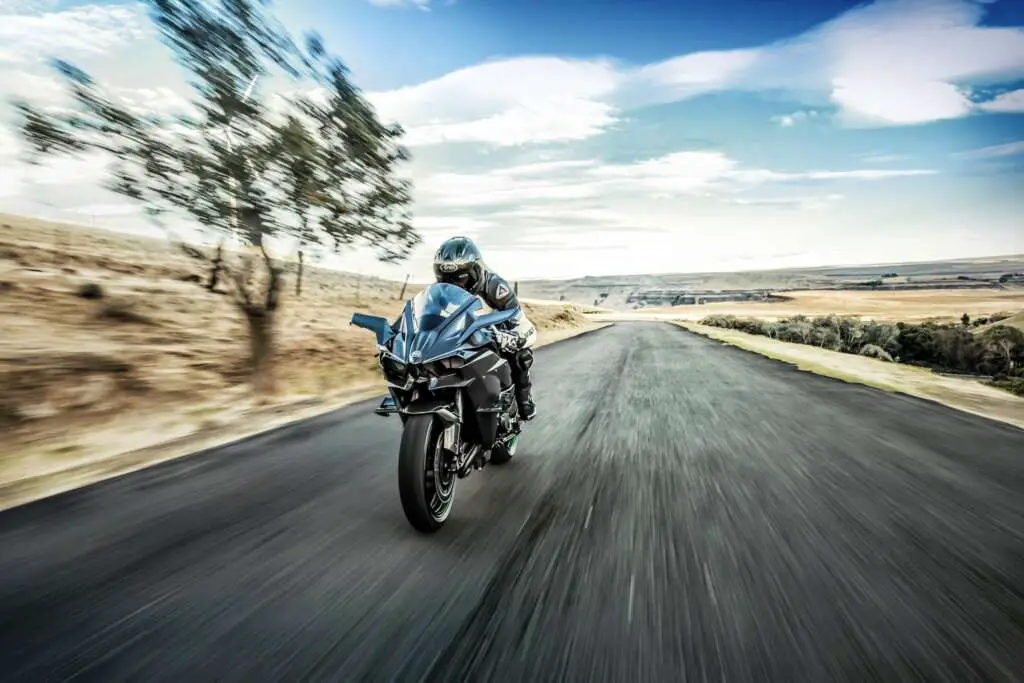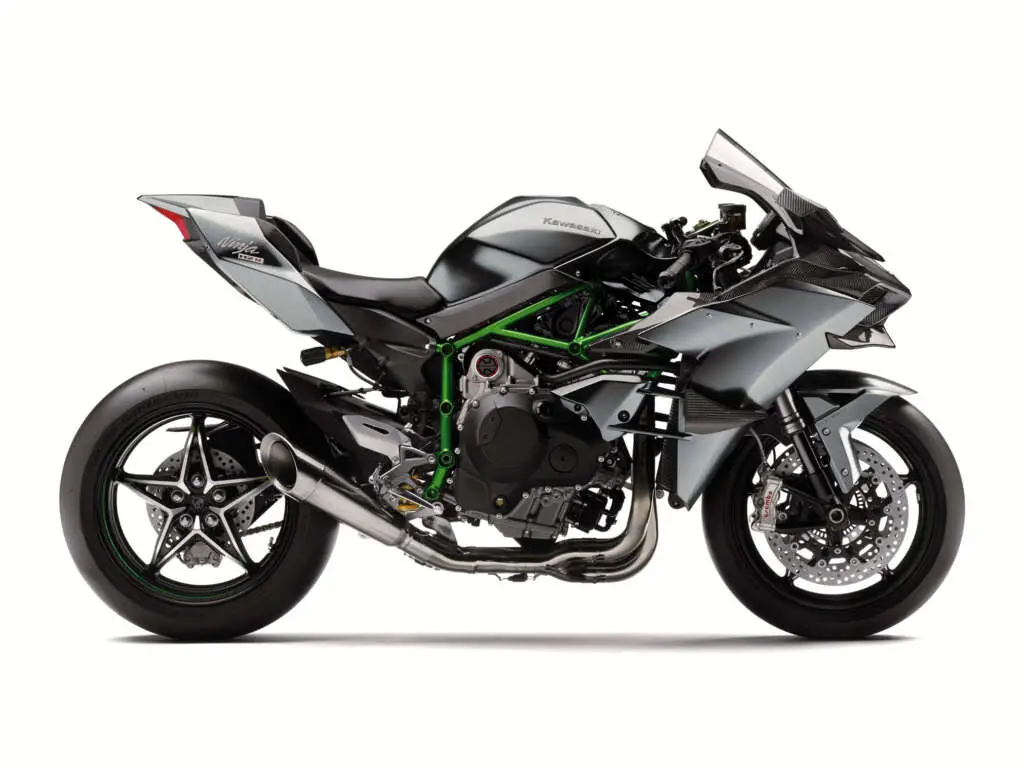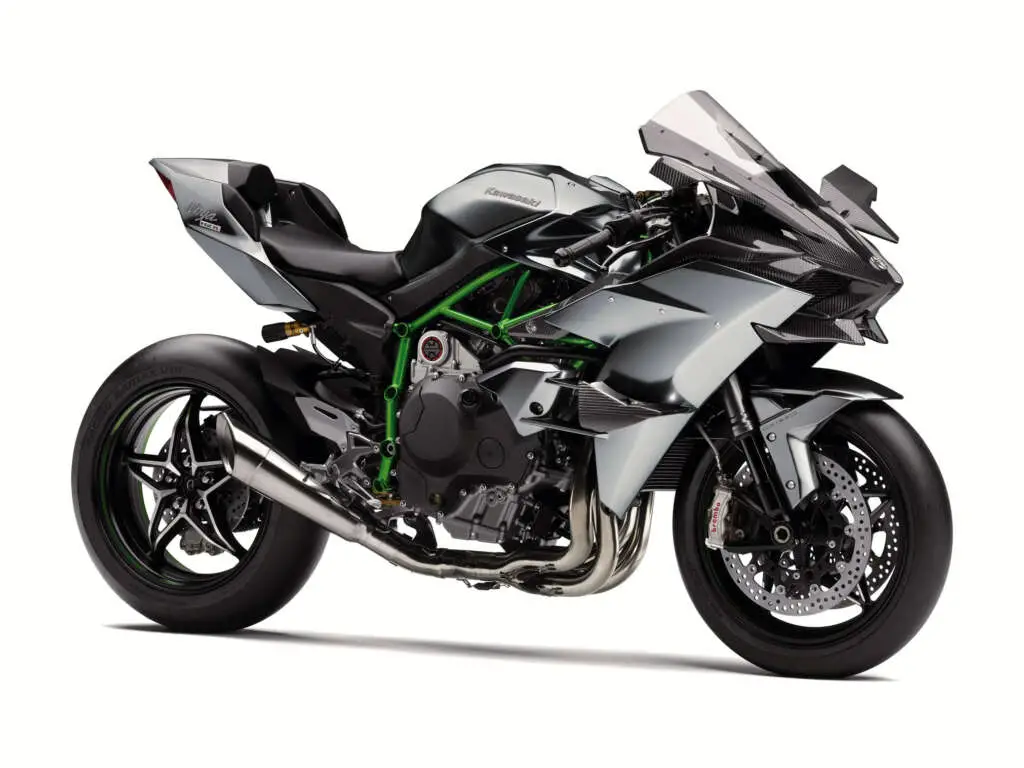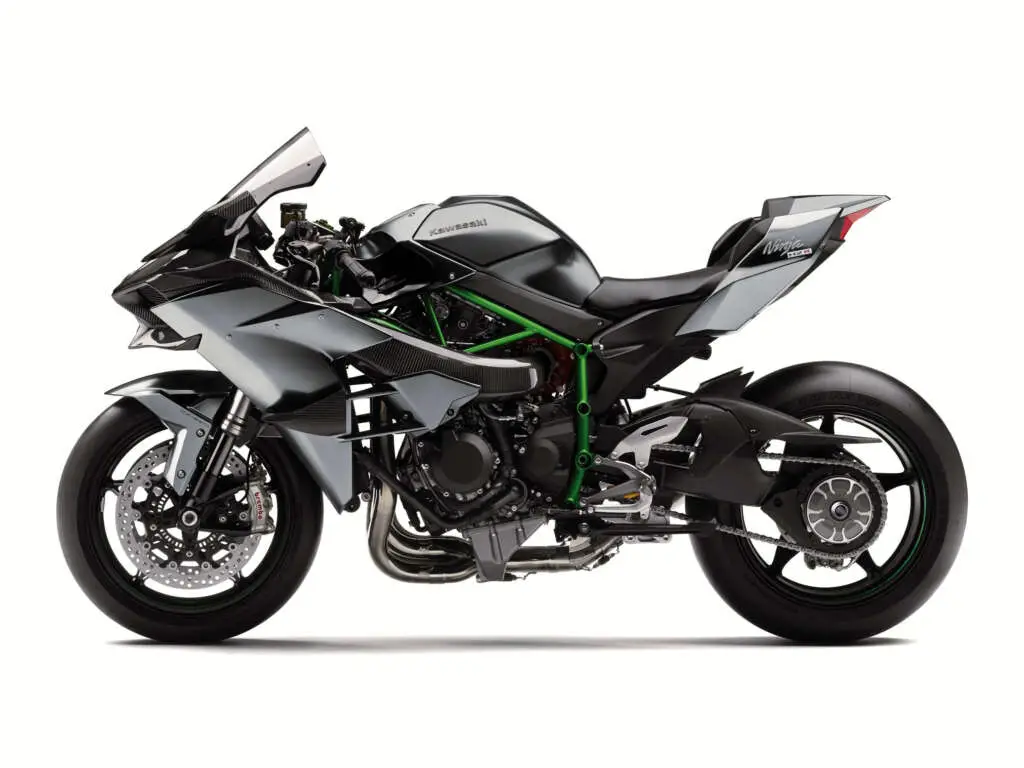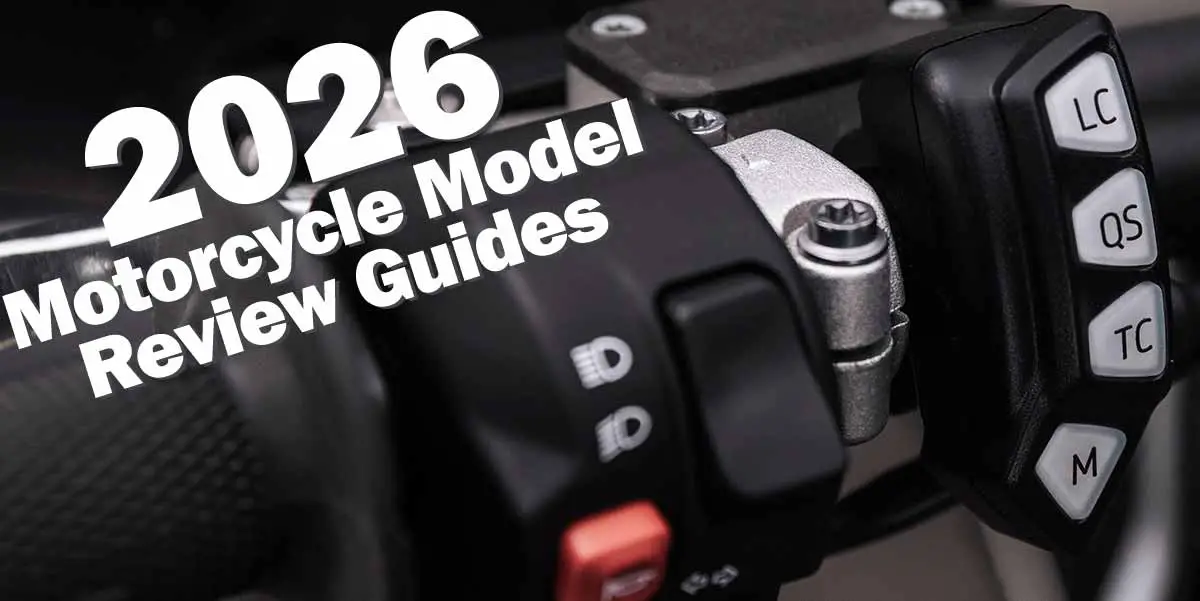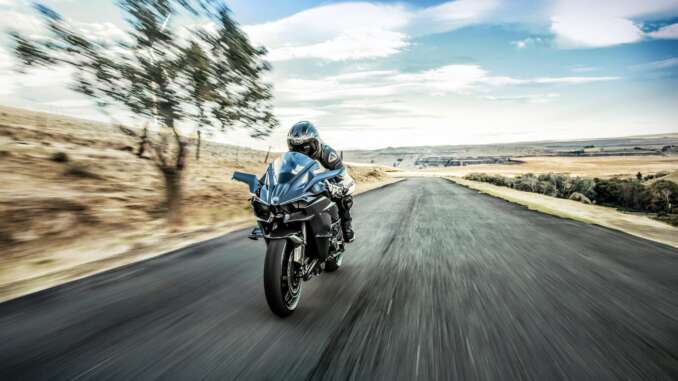
2022 Kawasaki Ninja H2R: ABSOLUTE DOMINATION.
Introducing the 2022 Kawasaki Ninja H2R…
Pushing engineering and performance boundaries is one of the few motorcycles that truly deserve to be called Instant Icons. Created without compromise and benefiting from the collective strength of Kawasaki Heavy Industries, the Ninja H2R demands respect and attracts the most skilled and committed riders. The H2R features: Ohlins rear suspension, up and down quick-shifter, aerodynamic devices, cornering management and a bank angle display. Ninja H2R, play your part in history. This Vehicle is not manufactured for public road use.
The development of the Ninja H2®R motorcycle goes beyond the boundaries of any other Kawasaki motorcycle. Born through the unprecedented collaboration between multiple divisions within the Kawasaki Heavy Industries, Ltd. (KHI) organization, the world’s only limited production supercharged hypersport model represents the unbridled pinnacle of Kawasaki engineering, with astonishing acceleration and mind-bending top speed suitable only for the track.
‘Built Beyond Belief’, the world’s only limited production supercharged hypersport model represents the unbridled pinnacle of Kawasaki engineering, with astonishing acceleration and mind-bending top speed suitable only for the track. The Ninja H2R features a 998cc inline four-cylinder engine, proprietary supercharger, lightweight trellis frame, compact superbike dimensions, carbon fiber aerodynamic devices, fully adjustable high-performance racing suspension and a rigid single-sided swingarm. This closed-course only motorcycle also features Kawasaki Launch Control Mode (KLCM), Brembo Stylema® monobloc calipers, Öhlins rear shock, highly durable self-healing paint and sits at the head of the class in advanced electronics and technological development.
The Kawasaki Ninja H2 is designed to be the ultimate performance street-legal motorcycle, built using state of the art technologies with cooperative development across Kawasaki’s high-performance motorcycle, aerospace and gas turbine divisions.
The Kawasaki 2022 line of hypersport motorcycles returns stronger than ever with its high-performance and supercharged Ninja H2R, Ninja H2 and Ninja H2 Carbon models.
2022 Kawasaki Ninja H2R Totalmotorcycle.com Key Features
- Closed-course only hypersport
- Carbon fiber aerodynamic devices
- Bosch IMU with Kawasaki’s dynamic modeling software
- Kawasaki Launch Control Mode (KLCM)
- Kawasaki TRaction Control (KTRC)
- Kawasaki Intelligent anti-lock Brake System (KIBS)
- Kawasaki Engine Brake Control (KEBC)
- Lightweight cast aluminum wheels
- Brembo Stylema® monobloc calipers
- Öhlins TTX36 rear shock with remote preload adjuster
- Highly durable self-healing paint
- KAWASAKI PROPRIETARY SUPERCHARGED TECHNOLOGY DELIVERS EXCEPTIONAL POWER AND TORQUE RIVALING A MOTO-GP MACHINE FOR THE ULTIMATE RIDING EXPERIENCE
- ENGINE DESIGNED FROM THE GROUND UP TO RELIABLY PERFORM AT THE HYPERBIKE LEVEL
- ELECTRONIC RIDING AIDS INCLUDE LAUNCH CONTROL, KAWASAKI TRACTION CONTROL AND KAWASAKI ENGINE BRAKE CONTROL
- SUPERCHARGED ENGINE PRODUCES 310PS*
*This engine is rated in PS power units. Gross Power is different than net power. Net power is generally less than gross, but varies with engine specifications. Gross power is a general measure to compare one engine to another, as to it’s overall performance.
The Kawasaki Ninja H2™R is the ultimate performance motorcycle, built using state of the art technologies with cooperative development across Kawasaki’s high-performance motorcycle, aerospace and gas turbine divisions.
Since it is designed exclusively for closed-course use, the Ninja H2R is a pure exercise in pushing the limits of technology. The result is the most powerful, distinctive, brutally functional and modern motorcycle ever offered. For those ready for the ride of a lifetime, the Ninja H2R will propel them like no other production motorcycle can.
2022 Kawasaki Ninja H2R Totalmotorcycle.com Features and Benefits
Economical Riding Indicator
Using high-precision electronic control for engine management, Kawasaki models can achieve a high level of fuel efficiency. However, fuel consumption is greatly affected by throttle use, gear selection, and other elements under the rider’s control. The Economical Riding Indicator is a function that indicates when current riding conditions are consuming a low amount of fuel. The system continuously monitors fuel consumption, regardless of vehicle speed, engine speed, throttle position and other riding conditions. When fuel consumption is low for a given speed (i.e. fuel efficiency is high), an “ECO” mark appears on the instrument panel’s LCD screen. By riding so that the “ECO” mark remains on, fuel consumption can be reduced.
While effective vehicle speed and engine speed may vary by model, paying attention to conditions that cause the “ECO” mark to appear can help riders improve their fuel efficiency – a handy way to increase cruising range. Further, keeping fuel consumption low also helps minimize negative impact on the environment.
Electronic Throttle Valves
Kawasaki’s fully electronic throttle actuation system enables the ECU to control the volume of both the fuel (via fuel injectors) and the air (via throttle valves) delivered to the engine. Ideal fuel injection and throttle valve position results in smooth, natural engine response and the ideal engine output. The system also makes a significant contribution to reduced emissions.
Electronic throttle valves also enable more precise control of electronic engine management systems like S-KTRC and KTRC, and allow the implementation of electronic systems like KLCM, Kawasaki Engine Brake Control, and Electronic Cruise Control.
The Kawasaki Engine Brake Control system allows riders to select the amount of engine braking they prefer. When the system is activated, the engine braking effect is reduced, providing less interference when riding on the track.
KLCM (Kawasaki Launch Control Mode)
Designed to assist riders by optimizing acceleration from a stop, KLCM electronically manages engine output to minimize wheel spin when moving off. With the clutch lever pulled in and the system activated, engine speed is limited to a determined speed while the rider holds the throttle open. Once the rider releases the clutch lever to engage the clutch, engine speed is allowed to increase, but power is regulated to minimize wheel spin and help keep the front wheel on the ground. The system disengages automatically once a predetermined speed has been reached, or when the rider shifts into third gear. Depending on the model, riders can choose from multiple modes, each offering a progressively greater level of intrusion.
KCMF (Kawasaki Cornering Management Function)
Using the latest evolution of Kawasaki’s advanced modeling software and feedback from a compact IMU (Inertial Measurement Unit) that gives an even clearer real-time picture of chassis orientation, KCMF monitors engine and chassis parameters throughout the corner – from entry, through the apex, to corner exit – modulating brake force and engine power to facilitate smooth transition from acceleration to braking and back again, and to assist riders in tracing their intended line through the corner. The systems that KCMF oversees vary by model, but may include:
• S-KTRC/KTRC (including traction management and wheel lift management)
• KLCM (including traction management and wheel lift management)
– Designed to optimize acceleration from a stop
• KIBS (including pitching management and corner braking management)
• Kawasaki Engine Brake Control
KTRC (Kawasaki Traction Control)
KTRC, Kawasaki’s advanced traction control system provides both enhanced sport riding performance and the peace of mind to negotiate slippery surfaces with confidence. Multiple rider-selectable modes (the number of modes varies by model) offer progressively greater levels of intrusion to suit the riding situation and rider preference.
Less intrusive modes maintain optimum traction during cornering. Designed with sport riding in mind, they facilitate acceleration out of corners by maximizing forward drive from the rear wheel. And because Kawasaki’s sophisticated software bases its dynamic analysis on the chassis’ orientation relative to the track surface (rather than relative to a horizontal plane), it is able to take into account corner camber, gradient, etc., and adapt accordingly.
In the more intrusive modes (and for some models, in any mode), when excessive wheel spin is detected, engine output is reduced to allow grip to be regained, effectively enabling riders to negotiate both short, slippery patches (train tracks or manhole covers) and extended stretches of bad roads (wet pavement, cobblestone, gravel) with confidence.
Models equipped with IMU incorporate chassis-orientation feedback to offer even more precise management.
Supercharged Engine
Drawing on the know-how and technology possessed by the Kawasaki Heavy Industries, Ltd. (KHI), Kawasaki’s supercharged engine delivers high engine output while maintaining a compact design. The key to achieving this incredible performance lies in the engine’s supercharger – a motorcycle-specific unit designed completely in-house with technology from the Kawasaki Gas Turbine & Machinery Company, Aerospace Company and Corporate Technology Division.
One of the greatest benefits of designing the supercharger in-house and tailoring its design to match the engine’s characteristics was that engineers were able to achieve high-efficiency operation over a wide range of conditions – something that would not have been possible by simply dropping in or trying to adapt an aftermarket automotive supercharger.
The importance of high efficiency in a supercharger is that, as the air is compressed, power-robbing heat gain is minimal. And while many superchargers are able to offer high-efficiency operation in a very limited range of conditions, the Kawasaki supercharger offers high efficiency over a wide range of pressure ratios and flow rates – meaning over a wide range of engine speeds and vehicle speeds. This wide range of efficient operation (similar to having a wide power band) easily translates to strong acceleration. The supercharger’s high efficiency and minimal heat gain also meant that an intercooler was unnecessary, greatly saving weight and space, and enabling the engine’s compact design.
KQS (Kawasaki Quick Shifter)
Designed to help riders maximize their acceleration on the track by enabling clutchless upshifts with the throttle fully open, KQS detects that the shift lever has been actuated and sends a signal to the ECU to cut ignition so that the next gear can be engaged without having to use the clutch. On models that offer clutchless downshifts, during deceleration the system automatically controls engine speed so that the next lower gear can be selected without operating the clutch.
Kawasaki ABS
Kawasaki ABS systems use front and rear wheel sensors to constantly monitor wheel speed. Should information from either of the sensors indicate that wheel lock has occurred, the ABS ECU directs the pump in the ABS unit to modulate brake fluid pressure (releasing and reapplying pressure so that traction can be regained) until normal operation resumes. ABS offers rider reassurance that contributes to greater riding enjoyment.
ERGO-FIT
Proper fit is key for rider comfort and control. However, the ideal fit varies from rider to rider, depending on their physical dimensions and riding style.
ERGO-FIT® is an interface system designed to allow riders to find their ideal riding position. Various points of the chassis interface (the handlebar, footpegs and seat, etc.) can be adjusted through a combination of interchangeable parts and parts with adjustable positions. This enables a wide range of riders to find a riding position that offers both comfort and control. Feeling at one with their machine, they will be able to experience how Kawasaki machines are fun and rewarding to ride.
*Adjustable parts and their range of adjustability vary by model.
IMU-Enhanced Chassis Orientation Awareness
The strength of Kawasaki’s cutting-edge electronics has always been the highly sophisticated programming that, using minimal hardware, gives the ECU an accurate real-time picture of what the chassis is doing. Kawasaki’s proprietary dynamic modeling program makes skillful use of the magic formula tire model as it examines changes in multiple parameters, enabling it to take into account changing road and tire conditions.
The addition of an IMU (Inertial Measurement Unit) enables inertia along 6 DOF (degrees of freedom) to be monitored. Acceleration along longitudinal, transverse and vertical axes, plus roll rate and pitch rate are measured. The yaw rate is calculated by the ECU using Kawasaki original software. This additional feedback contributes to an even clearer real-time picture of chassis orientation, enabling even more precise management for control at the limit.
With the addition of the IMU and the latest evolution of Kawasaki’s advanced modeling software, Kawasaki’s electronic engine and chassis management technology takes the step to the next level – changing from setting-type and reaction-type systems to feedback-type systems – to deliver even greater levels of riding excitement.
KIBS (Kawasaki Intelligent anti-lock Brake System)
Kawasaki developed KIBS to take into account the particular handling characteristics of supersport motorcycles, ensuring highly efficient braking with minimal intrusion during sport riding. It is the first mass-production brake system to link the ABS ECU (Electronic Control Unit) and engine ECU.
In addition to front and rear wheel speed, KIBS monitors front brake caliper hydraulic pressure, throttle position, engine speed, clutch actuation and gear position. This diverse information is analyzed to determine the ideal front brake hydraulic pressure. Through precise control, hydraulic pressure is modulated in much smaller increments than with standard ABS systems. The system limits rear wheel lift under heavy braking and takes downshifting into account while braking, allowing the rider to manage the rear brake. And because of the finer control, kickback to the brake lever is minimal, resulting in a very natural feeling.
Silver-Mirror Paint
Kawasaki’s high-quality original paint has a highly reflective, glasslike metal appearance. Its debut on the 2015 Ninja H2™ and Ninja H2™R marked its first use on a mass-production vehicle in either the automotive or motorcycle industry.
In the shade the paint has the appearance of its base coat color, but once in the sunlight its highly reflective surface takes on the appearance of the surrounding scenery. The stark difference in the way the paint appears in the light and the shade emphasizes the sculpted shape of the bodywork on which it is applied.
The highly reflective surface is created by inducing a silver mirror reaction (a chemical reaction between a solution of silver ions and a reducing agent) that forms a layer of pure silver (Ag). This Ag layer is what creates the paint’s glasslike metal appearance. Compared to candy paints, which use aluminum flakes to generate a sparkling effect, the Ag layer appears as a uniform metallic surface.
In the shade the Ag layer is translucent, allowing the base coat color to show through. This gives the paint a deep, three-dimensional quality.
While the multiple layers of paint on typical mass-production models are done by robot painters, for this silver-mirror paint each layer – from primer to clear coat – is carefully finished by the hands of Kawasaki craftsmen to ensure a flawless, lustrous surface.
2022 Kawasaki Ninja H2R – Totalmotorcycle.com USA Specifications/Technical Details
US MSRP Price: $56500 USD
Canada MSRP Price: $62700 CDN
Europe/UK MSRP Price: £ See Dealer GBP (On The Road inc 20% Vat)
Engine Type 4-Stroke, 4-Cylinder, Liquid-Cooled, DOHC, 4 Valve Cylinder Head Supercharged
Displacement 998 cc
Bore & Stroke 76.0 x 55.0 mm
Maximum Torque 121.5 lb.-ft @ 12,500 rpm
Compression Ratio 8.3.1
Fuel System DFI® with 50mm Throttle Bodies (4) and Dual Injectors
Ignition TCBI with Digital Advance
Transmission 6-Speed, Dog-Ring
Final Drive Sealed Chain
Rake/Trail 25.1° / 4.3 in.
Front Wheel Travel 4.7 in.
Rear Wheel Travel 5.3 in.
Front Tire Size 120/60-17
Rear Tire Size 190/65-17
Wheelbase 57.1 in.
Front Suspension 43mm Inverted AOS-II Fork with Adjustable Compression and
Rebound Damping, Spring Preload Adjustability, and Top-Out Springs
Rear Suspension New Uni-Trak®, Ohlins TTX36 Shock with 22-way Compression
and Rebound Damping and Hand-Turn Preload Adjustability
Front Brake Type Dual Semi-Floating 330mm Discs with
Radial-Mount, Opposed 4-Piston Calipers
Rear Brake Type 250mm Disc with Opposed 2 Pistion Caliper
Fuel Tank Capacity 4.5 gal.
Seat Height 32.5 in.
Curb Weight= 476.3 lb.
(Specifications subject to change without notice.)
= Includes all necessary materials and fluids to operate correctly, full tank of fuel (more than 90% of capacity) and tool kit (if supplied).
(KP) = See Kaw-Pedia section for more details.
Note: This vehicle is not manufactured for use on public streets, roads or highways
2022 Kawasaki Ninja H2R – Totalmotorcycle.com Canadian Specifications/Technical Details
POWER
Engine 998cc, liquid-cooled, 4-stroke, DOHC 16-valve in-line four
Bore x Stroke 76.0 x 55.0 mm
Compression Ratio 8.3:1
Fuel System Fuel injection: ø50 mm x 4 with dual injection
Intake System Kawasaki Supercharger
Ignition Digital
Starting Electric
Lubrication Forced lubrication, wet sump with oil cooler
Transmission 6-speed, return
Clutch Wet multi-disc, manual
Final Drive Chain
PERFORMANCE
Frame Trellis, high-tensile steel, with Swingarm Mounting Plate
Front Suspension / Wheel Travel ø43 mm inverted fork with rebound and compression damping, spring preload adjustability and top-out springs / 120 mm (4.7 in)
Rear Suspension / Wheel Travel New Uni Trak, Öhlins TTX36 gas-charged shock with piggyback reservoir, compression and rebound damping and spring preload adjustability, and top-out spring / 135 mm (5.3 in)
Rake / Trail 25.1° / 108 mm
Steering Angle (L/R) 27° / 27°
Front Tire 120/600 R17
Rear Tire 190/650 R17
Front Brakes Dual semi-floating ø330 mm Brembo discs with radial-mount, Brembo Stylema monobloc, opposed 4-piston calipers
Rear Brake ø250 mm disc with Brembo, opposed 2-piston caliper
DETAILS
Dimensions (L x W x H) 2,070 x 850 x 1,160 mm (81.5 x 33.5 x 45.7 in)
Wheelbase 1,450 mm (57.1 in)
Road Clearance 130 mm (5.1 in)
Seat Height 830 mm (32.7 in)
Curb Mass** 216 kg (476 lb)
Fuel Capacity 17 litres
Instrumentation Analogue-style tachometer + full-digital LCD screen with digital speedometer, gear position indicator, odometer, dual trip meters, current mileage, average mileage, fuel consumption, coolant temperature, boost indicator, boost (intake air chamber) temperature, stopwatch (lap timer), and clock
2022 Kawasaki Ninja H2R – Totalmotorcycle.com European Specifications/Technical Details
Engine
Engine type Liquid-cooled, 4-stroke In-Line Four with Supercharger
Compression ratio 8.3:1
Valve system DOHC, 16 valves
Bore x stroke 76 x 55 mm
Displacement 998 cm³
Intake System Kawasaki Supercharger
Fuel system Fuel injection: Ø 50 mm x 4 with dual injection
Ignition Digital
Starting System Electric
Lubrication Forced lubrication, wet sump with oil cooler
Gear Performance & Transmission
Maximum torque 165 N•m {16.8 kgf•m} / 12,500 rpm
Maximum power 228 kW {310 PS} / 14,000 rpm
Maximum power with RAM Air 240 kW {326 PS} / 14,000 rpm
Transmission 6-speed, return, dog-ring
Clutch Wet multi-disc, manual
Primary Reduction Ratio 1.551 (76/49)
Gear Ratios 1st 3.188 (51/16)
Gear Ratios 2nd 2.526 (48/19)
Gear Ratios 3rd 2.045 (45/22)
Gear Ratios 4th 1.727 (38/22)
Gear Ratios 5th 1.524 (32/21)
Gear Ratios 6th 1.348 (31/23)
Final drive Sealed chain
Final reduction ratio 2.333 (42/18)
Suspensions Brakes & Suspension
Brakes, front Dual semi-floating 330 mm Brembo discs. Caliper: Dual radial-mount, Brembo Stylema monobloc, opposed 4-piston
Brakes, rear Single 250 mm disc. Caliper: Brembo, opposed 2-piston
Suspension, front 43 mm inverted fork with rebound and compression damping, spring preload adjustability and top-out springs
Suspension, rear Uni-Trak, Öhlins TTX36 gas-charged shock with piggyback reservoir, compression damping, rebound damping, preload adjustability and top-out spring
Dimensions Frame & Dimensions
Frame type Trellis, high-tensile steel with Swingarm Mounting Plate
Trail 108 mm
Wheel travel front 120 mm
Wheel travel rear 135 mm
Tyre, front 120/600 R17
Tyre, rear 190/650 R17
Steering angle L/R 27° / 27°
L x W x H 2,070 x 850 x 1,160 mm
Wheelbase 1,450 mm
Ground clearance 130 mm
Fuel capacity 17 litres
Seat height 830 mm
Curb mass 216 kg
Manufacturer Specifications and appearance are subject to change without prior notice on Total Motorcycle (TMW).


